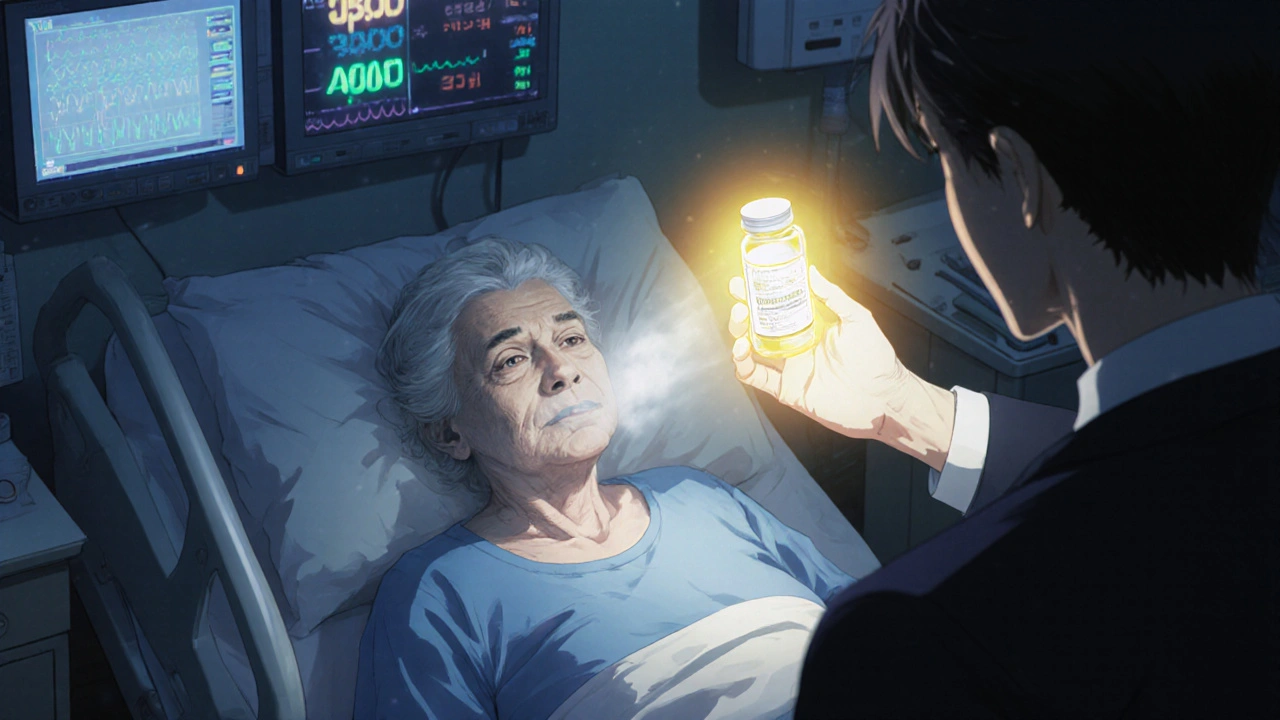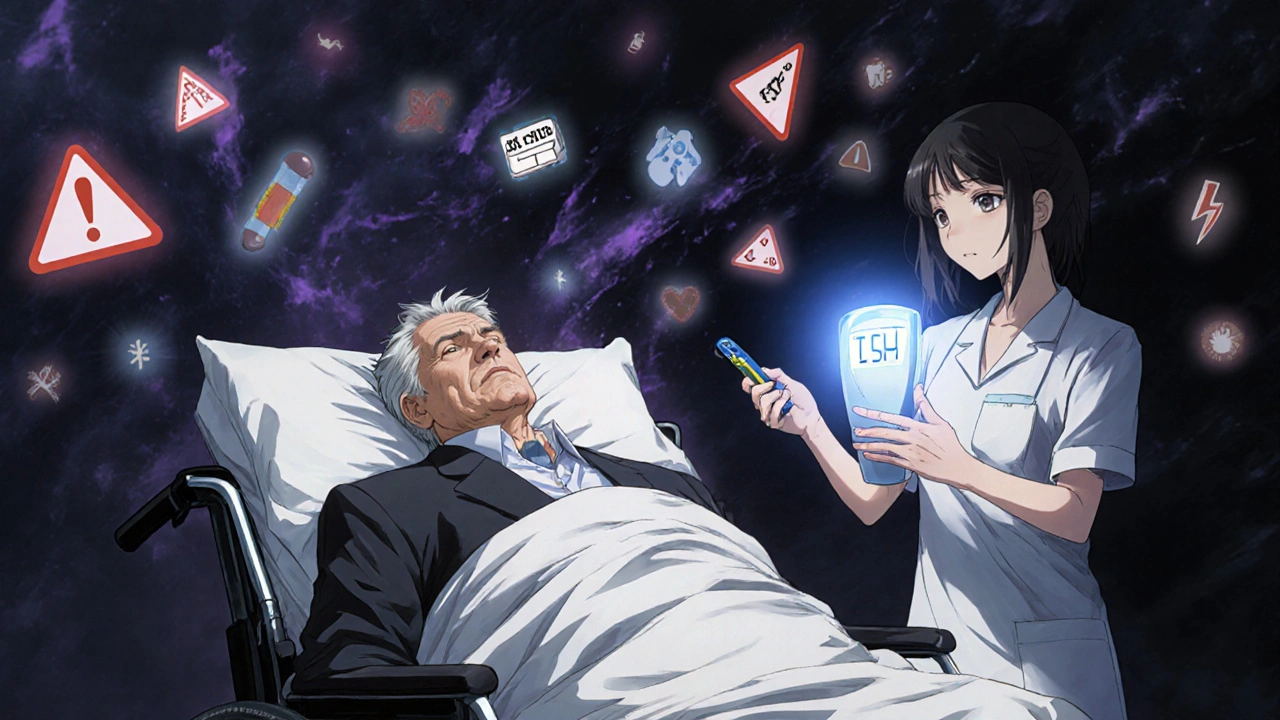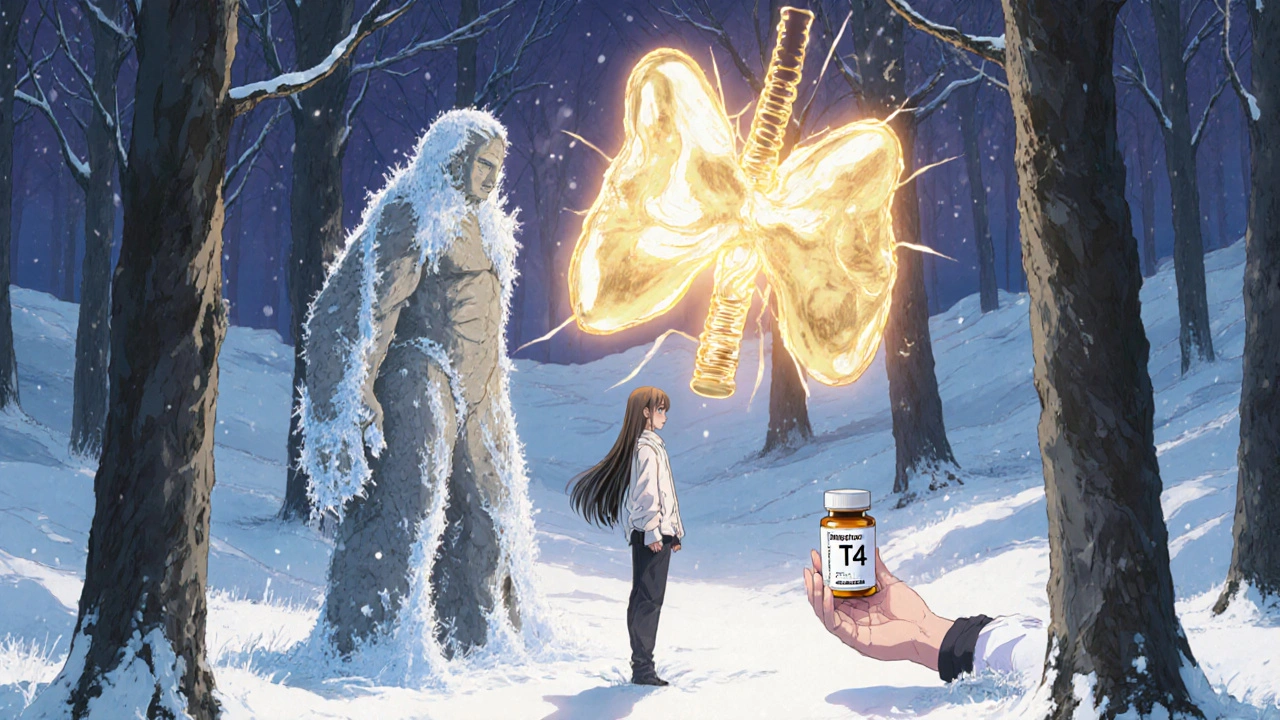
Myxedema coma isn’t just a rare complication of hypothyroidism-it’s a ticking clock. Every hour without treatment raises the risk of death by 10%. This isn’t a slow decline you can wait out. It’s a sudden, life-threatening collapse of multiple body systems triggered by dangerously low thyroid hormone levels. Even though it’s rare-only about 0.2 to 0.6 cases per million people each year-it’s one of the most dangerous endocrine emergencies doctors face. And the worst part? Many patients are misdiagnosed for months, sometimes years, before it hits.
What Exactly Is Myxedema Coma?
Myxedema coma, now more accurately called myxedema crisis, doesn’t always mean the patient is unconscious. The term "coma" is outdated. What matters is the body’s total failure to function under extreme thyroid hormone deficiency. It’s the end stage of untreated or poorly managed hypothyroidism, usually after years of being told "it’s just fatigue" or "you’re getting older."
At its core, myxedema crisis happens when your body runs out of the fuel that keeps your metabolism, temperature, heart, and brain working. Your T3 and T4 levels drop so low that your cells can’t do their jobs. Your heart slows. Your breathing gets shallow. Your body temperature plummets. Your brain fogs over. And if you don’t get help fast, your organs start shutting down.
It’s not random. Most people who develop it have had undiagnosed or untreated hypothyroidism for years. Maybe they stopped taking their medication during a hospital stay. Maybe they were never properly tested. Or maybe their symptoms-weight gain, dry skin, feeling cold all the time-were written off as normal aging.
The Warning Signs You Can’t Ignore
There’s no single test that confirms myxedema crisis. Diagnosis relies on recognizing a pattern of symptoms, especially in older adults. The classic triad is: altered mental status, hypothermia, and a triggering event.
- Altered mental status: This ranges from confusion and sluggishness to full unresponsiveness. In elderly patients, it often looks like depression or dementia. One study found 30% of older adults with myxedema crisis showed no typical thyroid symptoms-just mental fog.
- Hypothermia: Core body temperature below 35°C (95°F). Not just feeling chilly-your body can’t generate heat anymore. This is dangerous because your heart and lungs depend on warmth to function.
- Precipitating event: Something pushed the body over the edge. Infection (like pneumonia or a UTI) is the most common trigger, accounting for 30-50% of cases. Cold exposure, heart attack, stroke, or stopping thyroid medication are other big ones.
Other signs include:
- Heart rate under 60 bpm (bradycardia)
- Respiratory rate under 12 breaths per minute (hypoventilation)
- Swelling in the face, eyelids, and legs (non-pitting edema)
- Constipation or bowel paralysis (ileus)
- Low sodium levels (hyponatremia)-seen in 70-80% of cases
And here’s the kicker: women over 60 are three times more likely to develop it than men. But men? They’re more likely to be misdiagnosed because doctors don’t expect hypothyroidism in them. That delay costs lives.
Why Time Is the Enemy
Myxedema crisis kills in 25-60% of cases-even with modern care. Why? Because treatment is delayed.
Doctors often mistake it for infection, stroke, drug overdose, or heart failure. In the ER, a confused elderly patient with low temperature and slow breathing might get a CT scan for stroke, antibiotics for pneumonia, and a sedative for agitation. All the while, their thyroid is starving their body.
Here’s what experts say: Don’t wait for lab results. If you suspect myxedema crisis, start treatment immediately. Dr. Robert H. Eckel, former president of the American Heart Association, put it bluntly: "Treatment must not wait for laboratory confirmation."
Thyroid hormone levels can take hours to come back from the lab. By then, it might be too late. The first 30 minutes matter more than anything else.

Emergency Protocol: What Happens Next
There’s a clear, step-by-step plan. It’s called the DIMES mnemonic-Drugs, Infection, Myocardial infarction/CVA, Exposure, Stroke. It helps clinicians quickly spot what pushed the patient over the edge.
Here’s the emergency protocol, in order:
- Secure the airway: About half to 70% of patients need to be intubated because their breathing is too weak. Don’t wait for full respiratory failure.
- Give thyroid hormone right away: Intravenous levothyroxine (T4) is given in a loading dose of 300-500 mcg, then 50-100 mcg daily. In severe cases-especially with heart problems-liothyronine (T3) is added: 10-20 mcg every 8 hours. A new FDA-approved IV formulation, Thyrogen®, is now available and absorbs faster.
- Treat the trigger: If infection is suspected (and it often is), start broad-spectrum antibiotics immediately. Don’t wait for cultures.
- Warm the patient gently: No hot blankets, no heating pads. Active warming can cause dangerous drops in blood pressure. Use warm blankets, heated rooms, and monitor core temperature every 30 minutes. Let the body warm slowly as hormones kick in.
- Fix electrolytes slowly: Hyponatremia is common. But correcting sodium too fast can cause brain damage. Limit correction to 4-6 mmol/L in the first 24 hours.
One mistake that kills: rushing rewarming. Your body can’t handle the sudden metabolic demand if your thyroid hormones haven’t been restored yet. Slow and steady wins this race.
What’s New in 2025?
Guidelines changed in 2022. The Endocrine Society now recommends T3 (liothyronine) as first-line in patients with cardiac compromise, not just T4. A major trial showed a 15% drop in 30-day deaths when T3 was used early in severe cases.
Point-of-care thyroid testing is coming. Devices in phase 3 trials can give accurate TSH and free T4 results in under 15 minutes. Imagine an ER nurse running a quick blood test at the bedside and starting treatment before the patient even reaches the ICU.
Researchers are also looking at biomarkers. A 2023 Lancet study found that elevated thyrotropin receptor antibodies can predict who’s at risk of crashing-even before symptoms appear. That could change how we screen high-risk patients.

Who’s at Risk-and Why It’s Worse for Some
Myxedema crisis doesn’t pick favorites, but it does favor certain groups:
- Women over 60-especially those with Hashimoto’s thyroiditis
- People who stopped thyroid meds during hospitalization
- Those living in cold climates-Scandinavia has 50% higher rates than Mediterranean countries
- Uninsured or underinsured patients-studies show they wait 35% longer for treatment and have 22% higher death rates
And then there’s the silent epidemic: medical gaslighting. A 2022 survey of 427 hypothyroid patients found 18% had a near-miss event because their symptoms were dismissed. One woman spent 18 months labeled as depressed before collapsing into myxedema coma. Another man, in his 50s, was told his fatigue was "just stress"-until he stopped breathing in the ER.
Men, younger people, and those without obvious thyroid history are often missed. That’s why every doctor needs to ask: "Could this be thyroid?"-even if the patient doesn’t look like the textbook case.
What Happens After Survival?
Patients who survive myxedema crisis often recover quickly-if treated early. Many report feeling "like a different person" within 24 to 48 hours of starting hormone replacement. But recovery isn’t automatic.
Long-term, they need:
- Strict adherence to thyroid medication
- Regular TSH monitoring (every 6-8 weeks at first)
- Education on avoiding triggers: cold exposure, infections, skipping doses
- Coordination between endocrinologists and primary care
Some need lifelong ICU-level monitoring. Others bounce back fully. But the trauma stays. Many survivors say they now keep extra thyroid pills in their car, their purse, and their bedside drawer-just in case.
How to Prevent It
The best way to avoid myxedema crisis? Don’t let hypothyroidism go unchecked.
- If you’re on thyroid medication, never skip doses-even if you feel fine.
- If you’re hospitalized, make sure your thyroid meds are restarted ASAP. Don’t assume the hospital will remember.
- If you’re over 60 and have unexplained fatigue, weight gain, cold intolerance, or mental fog, ask for a TSH test. It’s cheap, fast, and life-saving.
- If you have Hashimoto’s or a family history of thyroid disease, get checked yearly-even if you feel okay.
And if you’re a caregiver or family member? Watch for subtle changes. A loved one who’s unusually quiet, cold, or confused? Don’t assume it’s aging. Push for a thyroid test. It could save their life.
Can myxedema coma happen without a history of hypothyroidism?
Yes, though it’s rare. Some people have undiagnosed hypothyroidism for years because symptoms are mild or mistaken for other conditions. Others develop it after thyroid surgery, radioactive iodine treatment, or certain medications like lithium or amiodarone. In these cases, there’s no obvious past diagnosis-but the body has been slowly failing for months.
Is myxedema coma the same as thyroid storm?
No. They’re opposites. Thyroid storm is caused by too much thyroid hormone-fast heart rate, high fever, agitation. Myxedema coma is caused by too little-slow heart rate, low temperature, lethargy. Treatment is completely different. Thyroid storm needs drugs to block hormone production. Myxedema coma needs hormone replacement. Confusing the two can be deadly.
Why can’t you just give more thyroid hormone to fix it?
You can-but it’s not that simple. Giving too much too fast can trigger a heart attack, especially in older patients with heart disease. That’s why dosing is carefully controlled: high initial IV dose, then gradual maintenance. Also, the body needs time to respond. Hormones don’t fix everything instantly. You also have to treat infections, rewarm slowly, and correct electrolytes. It’s a team effort.
Can you recover fully from myxedema coma?
Yes, if treated early. Many patients return to normal function within days. But if treatment is delayed, brain damage from low oxygen or prolonged low temperature can cause lasting cognitive issues. Recovery isn’t guaranteed-it depends on how long the body was deprived of thyroid hormone and how many organs were affected.
Are there warning signs before myxedema coma hits?
Yes. Before the full crisis, patients often have worsening fatigue, extreme cold sensitivity, confusion, constipation, and swelling. If someone with known hypothyroidism starts acting "off"-especially during illness or cold weather-treat it as an emergency. Don’t wait for coma to develop.
Comments (9)
-
Brenda Kuter November 17, 2025
Okay but have you ever heard of the thyroid conspiracy? The pharmaceutical companies don't want you to know that synthetic T4 is just a cover-up for the real cure-iodine crystals and sunlight. I know a woman who cured her myxedema by sleeping on a Himalayan salt bed and chanting mantras at 4 AM. They took her off meds, she’s running marathons now. The system is rigged. 🤫
-
Shaun Barratt November 17, 2025
While the clinical description of myxedema crisis is both accurate and urgently pertinent, I must note that the term 'myxedema coma' remains entrenched in the literature despite its obsolescence. The Endocrine Society's 2022 guidelines explicitly recommend 'myxedema crisis' to reflect the spectrum of clinical presentations, including those without complete unconsciousness. Precision in terminology is not pedantry-it is clinical necessity.
-
Iska Ede November 17, 2025
So let me get this straight-women over 60 are three times more likely to die because doctors think they’re just ‘getting old’? And men get ignored because they don’t fit the ‘typical’ hypothyroid profile? Ohhhhh so THAT’S why my aunt’s doctor told her to ‘take a nap and drink more water’ for 18 months before she coded. Classic. 😌
-
Gabriella Jayne Bosticco November 19, 2025
This is such an important post. I work in geriatric care and see this over and over-patients dismissed as ‘just tired’ or ‘depressed’ when it’s their thyroid screaming for help. That stat about 30% of elderly presenting with only mental fog? Chilling. If you’re caring for someone older and they’re just… off… don’t wait. Ask for TSH. It takes five minutes. Could save a life.
-
Sarah Frey November 21, 2025
Thank you for this comprehensive and meticulously detailed overview. The emphasis on early intervention-particularly the directive to initiate thyroid hormone replacement prior to laboratory confirmation-is clinically sound and aligns with current best practices. Furthermore, the caution against aggressive rewarming is critical, as rapid thermoregulation in the setting of profound metabolic suppression can precipitate cardiovascular collapse. This is a model of evidence-based clinical communication.
-
Katelyn Sykes November 22, 2025
My mom had this and no one believed her until she stopped breathing. She was 64. They thought it was dementia. We found her with a TSH of 180. They didn’t even test her thyroid until she was in the ICU. Don’t wait. If you’re tired, cold, and foggy and it’s been months-get tested. It’s a blood test. That’s it. I keep extra levothyroxine in my glovebox now. Just in case. 💪
-
Gabe Solack November 24, 2025
Big respect to the author for breaking this down. I’m a nurse in the ER and we get this more than you think. The biggest mistake? Giving sedatives to someone who’s hypoventilating because they ‘look sleepy.’ Nope. That’s their brain shutting down from no T3. 🚨 Also-yes to point-of-care testing. We’re testing TSH at the bedside now. Game changer. 🤝
-
Yash Nair November 25, 2025
USA has so much bad medicine. In India we know thyroid is sacred. Ayurveda cures this in 7 days with ashwagandha and guggul. Why do you trust pills from big pharma? You people are weak. My cousin had this and he took only herbal tea. Now he runs 10km daily. Your system is broken. 🇮🇳
-
Girish Pai November 27, 2025
From a clinical endocrinology standpoint, the 2022 Endocrine Society paradigm shift toward early T3 supplementation in high-risk cardiac cohorts represents a significant advancement in mortality mitigation. The pharmacokinetic advantage of T3’s shorter half-life enables more rapid tissue euthyroidism, particularly in myocardial and central nervous system tissues. Moreover, the emerging biomarker data on TRAb titers may enable predictive risk stratification with >85% specificity in Hashimoto’s populations-potentially transforming screening protocols from reactive to preemptive. This is translational medicine at its finest.
